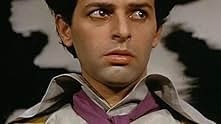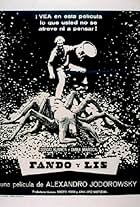A short mime adaptation of a Thomas Mann story about a Parisian urchin who makes her living selling human heads.A short mime adaptation of a Thomas Mann story about a Parisian urchin who makes her living selling human heads.A short mime adaptation of a Thomas Mann story about a Parisian urchin who makes her living selling human heads.
Photos
- Directors
- Writers
- All cast & crew
- Production, box office & more at IMDbPro
Storyline
Did you know
- TriviaThis film was thought to be lost for almost 50 years until a print was discovered in an attic in Germany.
- ConnectionsFeatured in Mark Kermode's Secrets of Cinema: Cult Movies (2021)
Featured review
a tale of love and loss, as performed by mimes and severed heads
This is quite the rare case: a story performed entirely in mime-form, where everything is silent but done so for a very physical effect by the actors/performers, that actually works. Usually mimes can be a little irksome (maybe not, depends on who's miming and how well the audience can take it), but Alejandro Jodorowksy, in his first attempt at film-making, makes this as experimental as something like Un Chien Andalou yet with an emotional core that can be understood by viewers open to it all. It's based on a novella by Thomas Mann about a woman who wants both her husband and lover back, and somehow gets their heads put into the wrong bodies!
There's a constant sense of both a dream in the scenery and body language, but disillusionment in what the characters are feeling back in their not-quite selves. There's the woman in particular, acted very well (she's the one sprawled out on a couch or other, with black hair, at least I *think* it's her), who responds to the Jodorowsky character at first with disdain, but then noticing his body changes her attitude. This is a brilliant little scene that calls back to those captivating, surreal moments in film-making of the silent era, and just in performing arts in general, where things were meant to be performed to be understood by the audience intuitively to an extent, not necessarily explained exactly.
It might be just as well; some moments in here call to the strengths of Jodorowsky's wild-man cinema even this early on, as figures in a 'city' environment pass by the disheartened husband, faces coming always close to the screen like it's meant to be fleeting but always impressionable via make-up and elaborate costumes. La Cravate, or the Severed Heads, also carries some unique traits as a Jodorowsky effort; the advantage of color is ever powerful and varied in tone from head to environment (different than what I expected from an underground director, especially as a precursor to Fando & Lis), but it's also a work that's usually more light than dark and more amusing than laugh-out-loud funny in its stabs of absurdism. One can't help but chuckle at one of the heads looking up and giving a wink and a smile to the helpless Jodorowsky or his counterpart, or in merely seeing the process of 'transposing' a head.
The music by Edgar Bischoff is also a factor for how sweet it is, contrasting the oddball mood of the material with melodies that sound like happy walks in the park. In short, it's a find that is quite a stroke of luck; the film was believed lost until rediscovered just in time for the DVD collection set, and for fans it's a minor delight. 8.5/10
There's a constant sense of both a dream in the scenery and body language, but disillusionment in what the characters are feeling back in their not-quite selves. There's the woman in particular, acted very well (she's the one sprawled out on a couch or other, with black hair, at least I *think* it's her), who responds to the Jodorowsky character at first with disdain, but then noticing his body changes her attitude. This is a brilliant little scene that calls back to those captivating, surreal moments in film-making of the silent era, and just in performing arts in general, where things were meant to be performed to be understood by the audience intuitively to an extent, not necessarily explained exactly.
It might be just as well; some moments in here call to the strengths of Jodorowsky's wild-man cinema even this early on, as figures in a 'city' environment pass by the disheartened husband, faces coming always close to the screen like it's meant to be fleeting but always impressionable via make-up and elaborate costumes. La Cravate, or the Severed Heads, also carries some unique traits as a Jodorowsky effort; the advantage of color is ever powerful and varied in tone from head to environment (different than what I expected from an underground director, especially as a precursor to Fando & Lis), but it's also a work that's usually more light than dark and more amusing than laugh-out-loud funny in its stabs of absurdism. One can't help but chuckle at one of the heads looking up and giving a wink and a smile to the helpless Jodorowsky or his counterpart, or in merely seeing the process of 'transposing' a head.
The music by Edgar Bischoff is also a factor for how sweet it is, contrasting the oddball mood of the material with melodies that sound like happy walks in the park. In short, it's a find that is quite a stroke of luck; the film was believed lost until rediscovered just in time for the DVD collection set, and for fans it's a minor delight. 8.5/10
- Quinoa1984
- May 12, 2007
- Permalink
Details
- Release date
- Country of origin
- Language
- Also known as
- The Severed Heads
- Filming locations
- See more company credits at IMDbPro
Contribute to this page
Suggest an edit or add missing content


















